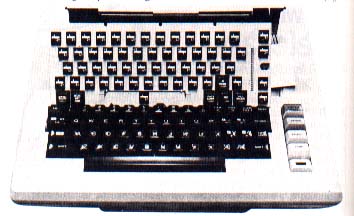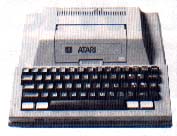400 UPGRADE
by GEORGE J. ADAMSON
No question about it, the ATARI 400 was, and is, a good little computer. Electronically it is almost identical to the 800, runs the same software, and for its price offers power and features still not fully matched by its competitors. But it does have its problems. Many 400 owners, fond of their machines, have opted to upgrade rather than trade them, and that's what this article is about.
Using add-ons made available by non-Atari companies (often called third-party vendors), it is now possible to have an ATARI 400 with a full-stroke keyboard, 50K available RAM, and a monitor jack. This brings the 400 to functional equivalency with the 800, and should satisfy any Atarian who isn't overawed by styling.
By early 1983 the price of the ATARI 400 had fallen to less than that once charged for the VCS game machine. There were, however, still the problems of the monopanel/membrane keyboard and limited memory. Apparently, the designers of the 400 thought the impermeable panel made good sense for use by youngsters, and it probably was cheaper to make. Nevertheless, the membrane is now widely considered to have been a mistake, and virtually all new computers are sporting real keyboards. Certainly any kind of voluminous data entry benefits from full-stroke keys.

The other limitation of the 400 is its memory, originally 8K and later increased to 16K RAM. This memory is built-in, and Atari in effect discouraged owners from increasing RAM with warnings about voiding the warranty, overheating, possible electric shock or damage to other delicate parts if the case were opened. No doubt these warnings were responsible caveats, but they served to keep the 400 owner unnecessarily hobbled if they were heeded.
To the rescue came several third-party vendors with full-stroke keyboards. First came Screen Sonics with its Sidewriter (see ANTIC #5), a detached keyboard of high esthetic and engineering quality, which unfortunately required a fair In-Home keyboard compared to ATARI 800 keyboard.
amount of soldering inside the computer. The keyboard emulated the 800, with the exception of the Atari logo key. The long umbilical gave the owner some of the convenience of other detached keyboards, and the Sidewriter continues to be an attractive, if expensive, upgrade still.
Other companies opted for the simpler fix. In-Home, a Canadian company which first tested its product in England, managed to get its first U.S. shipments into the stores by last Christmas, and met with immediate success. At the nominal cost of $45, the In-Home "B-Keyboard" replaces the membrane, sits inside the 400 housing, and looks like it came from the factory that way. However, five keys had to be relocated to the bottom row.
Although the B-Key takes only a couple of minutes to install, you might spend a half-hour or so pressing the keys in place and adjusting their movement. Photo 1 juxtaposes the B-Key with the 800 keyboard to show relative size and arrangement. From Colorado comes the Joytyper 400 at $130. It looks and feels like an 800 keyboard, except that the function keys have been moved next to the spacebar. One needn't relearn any typing skills with this model, but there is a question of esthetics. The Joytyper "sticks" on top of the ATARI case with adhesive pads, and in no way could it be mistaken for a factory model. (see Photo 2).
The newest entries in race include the Commander 400, from RCE; the Tara 400; and the Atto-Soft keyboard. The Commander offers custom options, such as numerical keypad, and ranges in price from $109 to $199. It is detachable, like the Sidewriter, but requires no soldering. It can be added to an 800 so that both keyboards are operable at the same time. The Tara 400 fits into the 400 case and boasts gold-plated key contacts. The Atto-Soft costs $90, but we frankly know little else about this keyboard just now.

The other big item in upgrading a 400 is memory expansion. It seems everyone under the sun is making a 48K expansion board for the 400. All these require removal of the original Atari RAM card and replacement with the expansion board. These give the 400 the same amount of usable memmory as the standard, fully-equipped 800 --37902 bytes.
Out of this explosion came the first 64K bank-selectable RAM card for the board has more memory than three built-in boards, and efficiently uses all of the memory available in a 6502 microprocessor. My son wanted to be the "first kid on the block" to have 64K RAM, so he raided his savings to pioneer the Mosaic board! We had some problems, but Mosaic has improved the design and we now believe this is the way to go. Mosaic guarantees all its boards--and Atari 400 with Joytyper installed. lived up to its guarantee in our experience, even though it took three units to
do it. The latest (working) unit has Motorola chips rather than the Japanese chips previously used, and perhaps that makes the difference.
The Mosaic board uses less current and generates less heat than the original 16K board. The BASIC cartridge isn't "hot" any more, even after several hours of programming. It must be installed carefully, however. The 22-pin power socket in our machine was weakened by all the exchanges, and had to be replaced by a technician. Besides, we had to wait a month to get it.
Was it worth the trouble? The 64K Select board is more efficient than the original, and allows 52K of RAM to be addressed at a time. Mosiac says this means 30% more workspace with the Atari Word Processor and 17% more with Visicalc.
The ATARI 400/800 reserved 16K of addressable RAM for the Operating System and the hardware registers. No doubt you have all seen the "10K ROM Operating System" board in the 800. Hardware consumes another 2K, but that still leaves 4K unaccounted for. Mosiac used this area to create four $K switchable banks, only one of which is active at a given time. This means that 52K is continuously available, and the balance can be selected in discrete 4K chunks.
The new ATARI 1200XL has something of the same arrangement already built-in, but it has a 14K OS that uses the 4K that was previously extra. However, a 400 with the 64K Select board is even better than a 1200XL in that it has 52K continuous free RAM, and the 1200 must "switch out" its Operating System to get that much. Who among us can write our own OS!
The original 16K Atari RAM board provides 13326; free bytes with BASIC installed. A 32K board boosts usable memory to 29710 bytes. These boards are now cheaper than the ATARI 16K board, and much cheaper than 48K- probably because demand is low for a half-full tank. A 48K board costs twice as much, but boosts memory only 8K to 37902 because BASIC occupies 8K of the top area, no matter what.
Mosaic's 64 Select expands into an area previously "unallocated." It can address 50190 bytes, almost four times as much as the original 16K board. It is more expensive than the 48K boards, but less on a $/byte basis.
By April a third version of Mosaic's expansion board (requiring a third printing of its owners manual, identified on the back cover as No. 229D) was already being shipped. This board eliminates messy soldering to the ROM cartridge socket, works in either a 400 or an 800, and, most pleasantly, carries a $50 price reduction to $199.95. The newest manual, with almost twice as many pages, offers more photos and even simpler step-by-step instructions for installation in either computer. The computer must be completely disassembled, exercising great care in lifting the 22-pin socket on the power board from its connector.
In its three years of existence, Mosaic has never stopped to relax and admire its work; it wants to be able to maintain its claim that "more Atari owners buy Mosaic memory than any other."
Mosiac is already offering membership in its own users group and even software to take advantage of the 48K memory banks. A package called "Handyman" eliminates the need to type "DOS" and thus preserves more memory for program use.
How did our tale end? In order to avoid "down-time" while waiting for the 400 to be repaired, we traded it on a demonstrator 800. The new 64K board will allow us to put as many as three of them in the 800 slots, creating 196,608 bytes. An 196K ATARI boggles the mind, but then that's another whole story in itself!